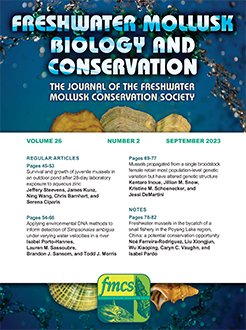Captive propagation followed by release to natural habitats has become a common conservation practice to restore and augment mussel populations, but the genetic effects of these efforts remain poorly studied. We examined genetic variation and genetic structure in 2- to 3-yr-old subadults of Lampsilis cardium and L. siliquoidea that each was propagated from a single broodstock female and subsequently used to augment existing wild populations. We compared genetic variation and structure of the propagated individuals to that of the wild population, including the broodstock females. Using microsatellite markers, we found that propagated subadults retained levels of heterozygosity comparable to the wild population and showed no sign of genetic bottlenecks. This is likely due to high levels of multiple paternity in both species, with the single broodstock females of L. cardium and L. siliquoidea mating with an estimated 13 and 25 sires, respectively. However, propagated subadults had significantly fewer alleles and lower allelic richness and altered allele frequencies compared with wild adults, and genetic structure of propagated individuals was distinct from the wild population. Our results show that propagation from even a single broodstock female can result in offspring that retain most population-level genetic variation. However, the reduced allelic richness and altered genetic structure we observed in propagated individuals underscore the need for future studies to investigate the ecological and evolutionary impacts of propagated individuals on wild populations.
How to translate text using browser tools
31 October 2023
Mussels Propagated from a Single Broodstock Female Retain Most Population-Level Genetic Variation but Have Altered Genetic Structure
Kentaro Inoue,
Jillian M. Snow,
Kristine M. Schoenecker,
Jessi DeMartini
augmentation
captive breeding
genetic variability
microsatellites
multiple paternity
parentage analyses
propagation





